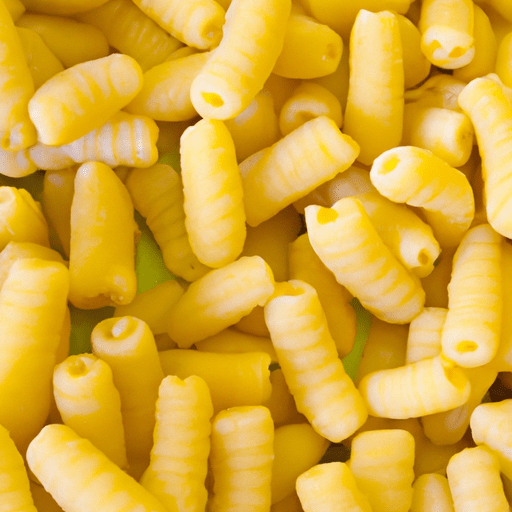The Delicious World of Cavatelli Pasta
When it comes to pasta, there is a wide variety to choose from, each with its unique characteristics and flavors. One such pasta that stands out for its delightful taste and versatility is cavatelli. In this blog post, we will dive into the wonderful world of cavatelli pasta, exploring its taste, common uses in cooking, nutritional value, and uncovering some interesting history and facts along the way.
Taste and Texture
Cavatelli pasta is known for its distinct shape and texture, making it a true delight to eat. This pasta is shaped like small shells or rolled-up dough, which gives it a playful and inviting appearance. The texture is beautifully balanced, with a slightly chewy exterior and a tender, doughy interior.
When cooked to perfection, cavatelli absorbs flavors from sauces and ingredients it is paired with, making it an excellent choice for hearty and flavorful dishes. Its unique texture allows it to hold on to pasta sauces, making every bite a burst of delectable taste.
Common Uses in Cooking
Cavatelli is a versatile pasta that lends itself well to a wide range of culinary creations. Traditionally hailing from southern Italy, it has become a staple not only in its place of origin but also in many other cuisines globally.
One popular way to enjoy cavatelli is in a classic tomato-based sauce, like a hearty Bolognese or a rich marinara. The rugged texture of the pasta perfectly complements the robustness of these sauces.
Cavatelli is also a fantastic choice for creamy pasta dishes. Its shape allows it to capture every bit of luscious sauce, making each forkful a decadent experience. Pair it with a creamy Alfredo or a velvety carbonara for a truly indulgent meal.
Additionally, this pasta works wonders in pasta salads or hearty soups. Its curved shape traps flavorful liquids, adding an extra dimension to any dish it graces.
Nutritional Value
When it comes to nutrition, cavatelli pasta can be a great choice for a balanced meal. It is primarily made with semolina flour, which offers a good source of carbohydrates, providing energy for the body.
Cavatelli is also low in fat and cholesterol-free, making it a healthy option for those watching their dietary intake. To further enhance your meal’s nutritional value, consider pairing cavatelli with an array of fresh vegetables, lean proteins, and healthy fats.
History and Interesting Facts
Cavatelli pasta has a fascinating history that dates back several centuries. It is believed to have originated in the southern regions of Italy, where local cooks would hand-roll small pieces of dough on traditional gnocchi boards or the back of a fork to achieve its characteristic shape.
The name “cavatelli” derives from the Italian word “cavato,” meaning hollowed-out. This refers to the unique shape of the pasta, which provides a delectable pocket for capturing sauces and other ingredients.
While traditionally made with just flour and water, modern variations of cavatelli pasta may incorporate ingredients such as spinach, tomatoes, or even herbs, adding an extra burst of flavor and color to the dish.
Cavatelli has gained popularity globally, making appearances on restaurant menus and home-cooked meals worldwide. Its charm lies in its versatility, enabling both simple and extravagant preparations.
In Conclusion
The delightful features and versatility of cavatelli pasta have made it a favorite among food enthusiasts worldwide. With its tangy taste, beautiful texture, and ability to pair well with various sauces and ingredients, this pasta offers endless possibilities in the kitchen.
Next time you are looking to add a touch of Italian flair to your table, consider embracing the delightful world of cavatelli. Whether enjoyed in a comforting bowl of tomato sauce, a rich cream-based dish, or a vibrant pasta salad, cavatelli will undoubtedly leave you craving more.
Cavatelli Pasta
Origin: Cavatelli pasta is a traditional type of pasta that originated in Southern Italy, specifically in the regions of Puglia, Basilicata, and Calabria. It has been enjoyed as a staple in Italian cuisine for many generations.
Common Uses: Cavatelli pasta is commonly used in various Italian dishes, particularly in Southern Italy. It is often paired with rich tomato-based sauces, vegetable sauces, and meat sauces. It can also be used in pasta salads and baked dishes.
Nutritional Benefits: Cavatelli pasta is primarily made from semolina flour, which is a durum wheat flour. It provides a good source of complex carbohydrates and dietary fiber. It also contains some protein and small amounts of essential vitamins and minerals.
Unique Properties: Cavatelli pasta is characterized by its small, elongated shell-like shape. The dough used to make cavatelli is usually made by combining semolina flour, water, and sometimes eggs. The dough is rolled into small pieces and then shaped by rolling it against a ridged wooden board or pressing it with the fingers, giving it its distinctive grooved appearance.
Historical Significance: Cavatelli pasta can be traced back to ancient times in Italy, where pasta-making was a common culinary practice. It became particularly popular in the Southern regions of Italy, where it was traditionally made by hand. Over time, cavatelli pasta has become a beloved part of Italian culinary heritage and is still enjoyed today in both traditional and modern Italian cuisine.




Use the share button below if you liked it.
It makes me smile, when I see it.